
Welcome To
The James Museum from Home
Connect with us through curated content based on our collection. Explore art, movies, books, music, family activities and more. Each theme is freshly considered and developed by our curatorial and education teams. We invite you to discover a new way to experience the museum and learn more about our collection.
Theme: Indian Artists
Spotlighting influential 20th century Native American artists in The James collection, read about how these painters and sculptors were also art pioneers.
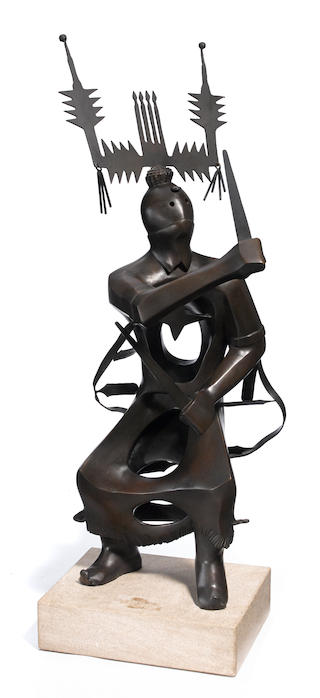
Allan Houser (Chiricahua Apache), 1914–1994
Abstract Crown Dancer
1991
Bronze
Art Spotlight
By: Caitlin Pendola | Curatorial Associate
The organic, emotional charge that is present in Houser’s sculptures is not as much about what is there, but more about what is not, such as here in Abstract Crown Dancer. Houser activates the space by utilizing negative space. He creates a closed circuit of energy with his sweeping, uninterrupted lines. This sense of weightlessness in the form allows the sculpture to graduate from being a representational body to being a spirit, a feeling. Arguably, he is most known for this ability to capture the spiritual essence of a group of people in a single, simple form. Even with a relatively little amount of detail, the viewer still can easily identify this figure as an Apache crown dancer. It is yet another example of the power in what is not there.
Houser is considered a master artist not only due to his world-renowned sculptural works, but also because he made inspiring works in several different mediums—drawing, painting, printmaking, book illustration and, of course, sculpture—over the course of seven decades. His lifetime achievements also include teaching younger generations of Native American artists, thus having a profoundly positive impact on their lives and art. He paved the way for combining what was considered traditional Indian art with modern art. Today, his work is still known for its quiet, contemplative way of embodying the pride, honor and tenacity of American peoples.
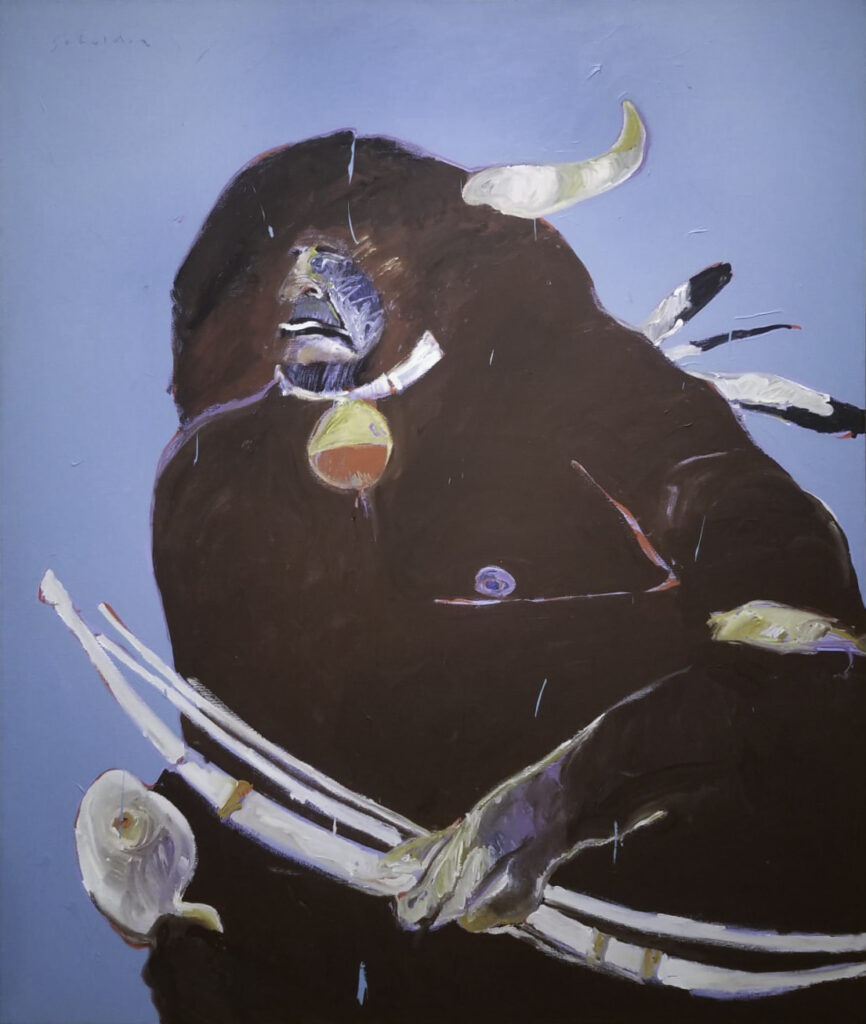
Fritz Scholder (1937–2005)
Buffalo Dancer
1975
Art Spotlight
By: Caitlin Pendola | Curatorial Associate
Ironically, he became one of the most prominent American Indian artists of his time, becoming well known for his large-scale Indian portrait series of the 1960s and ’70s. Today he is still widely regarded as revolutionizing Native American art, and his work can be found nearly everywhere American Indian art is displayed. His art is in opposition to the romantic depictions often found in the Western art genre. As seen here in Buffalo Dancer, Scholder’s style is bold, aggressive and often deliberately dissonant. It could be said that the isolated figure appears to be in a tortured state of transition, as the weighty, fluid body and the grotesque face both seem to imply action. He uses no shadow or horizon line, and color is a means of expression rather than representation.
Above all, Scholder considered himself a colorist. Subject matter was third on his list of what is important about a painting. In contrast, many artists begin with the subject matter, and then explore techniques and approaches. Scholder reversed these steps. His unorthodox use of color, and his love affair with the sensory qualities of paint—how it smears, drips and mixes—produced active paintings that evoked an emotional response, and not always a positive one.
Notwithstanding the controversy surrounding his Indian series, Scholder became the face of a new movement of ideas in the art world. He shifted the emphasis from one of Native art primarily being about culture and history to a contemporary focus confronting stereotypes. His body of work also brought to light questions surrounding what Indian art is and to what extent a person needed to live a “traditional” life to be considered an Indian artist.
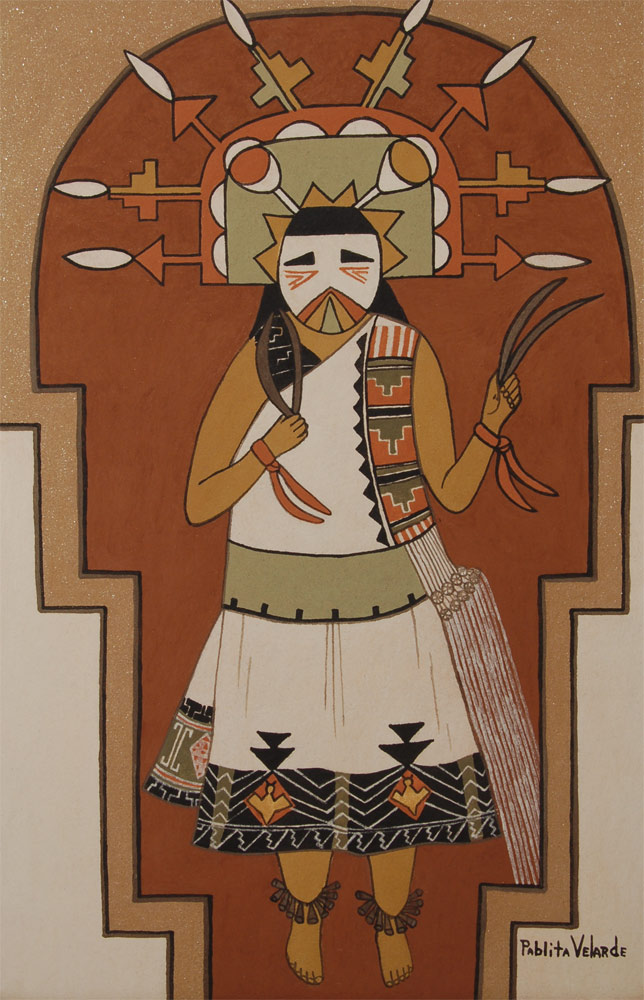
Pablita Velarde
Santa Clara (Kha’p’o Owingeh), 1918–2006
Palhik Mana Katsina, c.1960
Earth pigments on Masonite
Art Spotlight
By: Emily Kapes | Curator of Art
Santa Clara Pueblo artist Pablita Velarde (1918–2006) is one of a handful of women Pueblo painters to achieve prominence. Her path helped pave the way for future generations during a time when Pueblo women’s traditional duties rarely strayed beyond the domestic, and creative efforts were reserved for making pottery. Early on, her career choice was considered inappropriate by many, but the criticism and discrimination she faced did not diminish her determination to paint. Velarde eventually proved herself, however, and her depictions of Indian ceremony and daily life have meticulous attention to detail—so much so that her paintings have become valuable historical records.
Velarde overcame hardship early in life. At three years old, she was blinded by an eye disease. Indian herbs helped to recover sight in her right eye after two years, but her left eye remained damaged. That experience left her with a lifelong desire to remember details that later informed her paintings. At age six, after her mother died of tuberculosis, her father could not both work and care for Velarde and her three sisters. He reluctantly sent them to St. Catherine’s Indian School in Santa Fe, where nuns taught them English, math and vocational skills but attempted to strip away their Indian culture. Summers with their father on the farm helped them retain their native Tewa language as well as ceremonial traditions.
Velarde’s art training began as a teenager at the Santa Fe Indian School. She was the first full-time female painting student of Dorothy Dunn, the Studio’s influential teacher in the 1930s. Dunn took Velarde under her wing and helped to grow her confidence in life and art. Dunn emphasized creating illustrative and narrative portrayals of ceremonies and culture in a style based on heavily outlined flat fields of color using opaque watercolors. She also had the students paint earth pigment murals on the Studio walls, where Velarde learned about using natural materials like ground clay and rocks with adhesives to make paint. She later refined the process in her own work with great success (fig. 1).
Velarde was 19 when she was commissioned to create scenes of traditional Pueblo culture for the museum at Bandelier National Monument. From 1937 to 1943, she produced over 70 paintings there and learned a great deal about what she wanted in her career. She also started entering art shows and competitions, where she gradually gained recognition and major awards, often as the first female recipient. She also became a mother to future artist Helen Hardin (1943–1984).
In the decades that followed, Velarde was able to be a full-time professional artist. She experimented with style and medium but continued with traditional Pueblo subjects. Her independence and perseverance helped her become one of the most accomplished Native American painters of her generation, with solo exhibitions throughout the United States. The James Museum is one of many institutions with Pablita Velarde paintings in the collections.
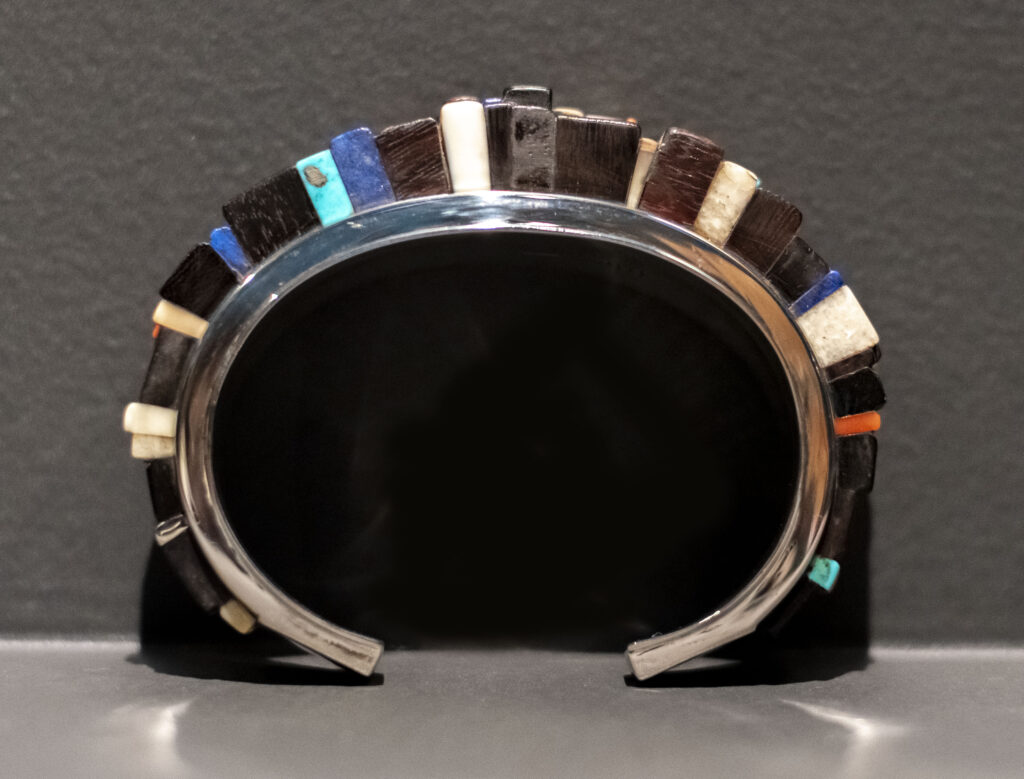
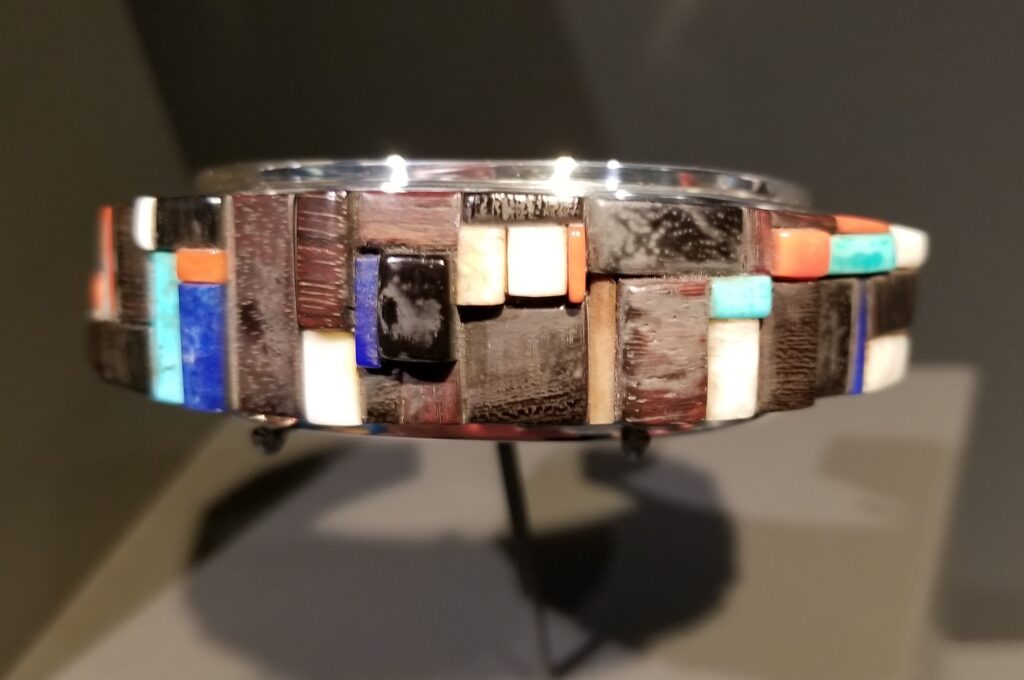
Charles Loloma
Stacked Ironwood Bracelet
Date unknown
Sterling silver, ironwood, turquoise, lapis, coral, fossil Ivory
Art Spotlight
By: Jason Wyatt | Collections Manager
In 1941 Loloma was drafted for military service in World War II, and he served as a noncombat camouflage expert in the Aleutian Islands. After his discharge in 1945, Loloma used the GI Bill to attend the School for American Craftsmen at Alfred University in New York. There, he broke from Hopi norms and studied ceramics, an art form traditionally practiced by Hopi women. After graduation Loloma moved back to Arizona, where his pottery began to gain recognition for its distinctly modern designs with minor Hopi influences seen in glaze colors and stylized Hopi symbols. Loloma and his wife, Otellie, also an artist, rented a space in 1954 in the newly established Kiva Craft Center, founded by his former teacher Lloyd Kiva New. There, artists could rent small studio spaces in a communal setup to make and sell their art. In this setting, Loloma gained inspiration from the other artists, such as architect Paolo Soleri and jeweler H. Fred Skaggs. He was also influenced by Frank Lloyd Wright, whom he would visit with New at Taliesin West, Wright’s winter home in Scottsdale.
Loloma began experimenting in the late 1950s with jewelry fabrication. These early attempts used tufa casting to fabricate details on New’s leather handbags and shirt designs. Loloma traveled to Paris in 1963 for a small exhibition of his jewelry. While there he discovered the exclusive world of haute couture and was influenced by its ability to showcase cutting edge designs. Paris was also where he conceived of an early signature piece, the single long dangle earring, yet another break from tradition.
Loloma traveled the world, picking up ideas and influences from each place he visited. A trip to Asia inspired him to begin introducing pearls in his designs. From Egypt, the ancient hieroglyphs and stylistic sculptural forms influenced his pendants of the Hopi gods. The ability to mix many cultural influences with his own Hopi culture helped with the success of his jewelry designs. Instead of exclusively using silver in his designs, Loloma was one of the first artists to utilize gold, elevating his jewelry to a high-end clientele. Small amounts of turquoise added pops of color to the nontraditional materials he used—such as wood, coral, lapis, fossilized ivory, and malachite.
Loloma’s most important and lasting influence on the contemporary Native American jewelry movement was his stacked, or height, designs found on bracelets. The design employed the use of tall vertical slabs of stone, wood and/or fossilized ivory set on the short end into a precious metal base. This allowed the owner to see the bracelet in two distinct views. From above the bracelet looked like a traditional flat inlayed design, but with a slight turn it became something more sculptural and revealed a greater height and circumference. Loloma inspired Native American artists not only with his jewelry innovations, but also in the way he lived his life. His ability to travel led to a broader worldview that influenced his work and allowed him to break from the expected traditional Hopi style. But the artist also stayed true to his Hopi roots and lived most of his life in Hotevilla on Third Mesa, straddling a simple village life and the outside world of fame and fortune.
